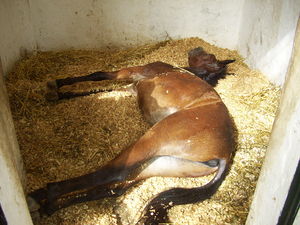Difference between revisions of "False Colic in the Horse"
Jump to navigation
Jump to search
| Line 9: | Line 9: | ||
* Testicular torsion | * Testicular torsion | ||
* Pleuritis / pleuropneumonia | * Pleuritis / pleuropneumonia | ||
| − | * [[ | + | * [[laminitis|Laminitis]] |
* Rhabdomyolysis | * Rhabdomyolysis | ||
* Urinary tract obstruction / rupture | * Urinary tract obstruction / rupture | ||
Revision as of 09:52, 24 June 2010
| This article has been peer reviewed but is awaiting expert review. If you would like to help with this, please see more information about expert reviewing. |
False colic
Signs of colic may be caused by abdominal pain not associated with the gastro-intestinal tract. It is important to differentiate these from true colic to ensure that the best and appropriate treatment is given. This can be acheived by a thorough history and clinical examination.
Caueses of False Colic
- Dystocia / Uterine torsion
- Testicular torsion
- Pleuritis / pleuropneumonia
- Laminitis
- Rhabdomyolysis
- Urinary tract obstruction / rupture
- Liver disease
- Aortoiliac thrombosis
- Splenic lesions
- Diseases affecting the central nervous system e.g. Tetanus
- Ovulation
- Granulosa Theca Cell Tumor
References
- Archer D. (2004), Decision making in the mangement of the coliky horse, In Practice in Equine Gastroenterology courtesy of the University of Liverpool
